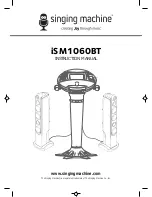
7
SERIE
CMDS
CMDS
CMDS
CMDS
CMDS
3
FUNZIONI E CONNESSIONI
3.3 INGRESSO AUSILIARIO E CD
Alle prese phono “AUX” e “CD” [24] è possibile collegare, rispettivamente,
una sorgente musicale ad alto livello (registratore a nastro, radioricevitore
per microfoni senza filo, ecc.) e un riproduttore di compact disc. I controlli
di livello [10] permettono di dosare opportunamente l’ampiezza dei
segnali relativi a questi due ingressi.
3.4 USCITA ALTOPARLANTI
Le uscite di potenza per i diffusori sono disponibili sulla morsettiera
[19]. È possibile realizzare un impianto di diffusione sonora utilizzando
sia diffusori a bassa impedenza, sia diffusori dotati di traslatore di linea.
In entrambi i casi il carico complessivo non deve essere tale da
sovraccaricare l’amplificatore: si raccomanda, cioè, di non applicare
diffusori o gruppi di diffusori con impedenza più bassa di quella nominale
della presa alla quale sono collegati. Non è consigliabile realizzare
impianti di diffusione misti (a bassa impedenza e a tensione costante).
3.3 CD AND AUXILIARY INPUT
A high-level source of music (tape recorder, radio-receiver for wireless
microphones, etc.) and a compact disk player can be connected
respectively to the “AUX” and “CD” sockets [24]. Thanks to the level
controls [10], it is possible to adjust the amplitude of the signals for
these two inputs in the appropriate manner.
3.4 LOUDSPEAKERS OUTPUT
The power outputs for the loudspeakers are available on the terminal
strip [19]. It is possible to set up a sound-broadcasting system using
either low-impedance loudspeakers or loudspeakers equipped with a
line transformer. In either case, the overall load must not be such as to
overload the amplifier. It is therefore advisable not to connect
loudspeakers or groups of loudspeakers with lower impedance values
than the rated impedance of the socket to which they are connected. It
is not advisable to set up mixed broadcasting systems (using both low-
impedance and constant-voltage equipment).
3.4.1
LOW IMPEDANCE SYSTEMS
For applications requiring use of a small number of loudspeakers, the
line linking them can be connected between the common terminal “0”
and one of the three 4, 8 or 16 ohm sockets of the terminal strip [19].
The connection of the loudspeakers, of the series or parallel or mixed
type, must supply an impedance calculated to be equal to one of the
three sockets. Figure 3.4.1 shows an example of a connection with two
8 ohm loudspeakers connected in parallel.
3.4.2 CONSTANT VOLTAGE SYSTEMS
In the case of systems with a large number of loudspeakers and/or in
which the distances between the amplifiers and the loudspeakers is
very large, it is preferable to use a constant voltage distribution system
(also known as a high-impedance system). In this type of system, the
loudspeakers, which are equipped with transformers for adapting the
impedance, are all shunted to the line (see the example in Figure 3.4.2).
Because of this, the system is easy to set up, and if one of the
loudspeakers should become disconnected from the line for any reason,
the rest of the system would continue to work normally. The constant
voltages available as outputs from the amplifier are 70 and 100 V, with
rated impedance values of 41 and 84 ohm respectively.
FUNCTIONS AND CONNECTIONS
Fig. 3.4.1
Fig. 3.4.2
3.4.1 SISTEMI A BASSA IMPEDENZA
In applicazioni che richiedono l’uso di pochi altoparlanti, la linea di
collegamento può essere connessa tra il terminale comune “0” ed una
delle tre prese 4, 8 o 16 ohm della morsettiera [19]. Il collegamento
degli altoparlanti, di tipo serie o parallelo o misto, deve fornire
un’impedenza calcolata pari ad una delle tre prese. In figura 3.4.1 é
riportato un esempio di collegamento con due altoparlanti da 8 ohm
ciascuno connessi in parallelo.
3.4.2 SISTEMI A TENSIONE COSTANTE
Nel caso di impianti con un gran numero di diffusori e/o con distanze tra
amplificatori ed altoparlanti molto elevate é preferibile utilizzare un
sistema di distribuzione a tensione costante (definito anche ad alta
impedenza). In questo tipo di impianto, i diffusori, provvisti di trasformatori
di adattamento di impedenza, sono tutti collegati in derivazione alla
linea (vedi es. di Fig. 3.4.2); questo par ticolare rende di facile
realizzazione l’impianto e, nel caso in cui un altoparlante dovesse per
qualche motivo scollegarsi dalla linea, il resto dell’impianto
proseguirebbe nel suo regolare funzionamento. Le tensioni costanti
disponibili in uscita dall’amplificatore sono da 70 e 100 V, con impedenza
nominale, rispettivamente, di 41 e 84 ohm.








































